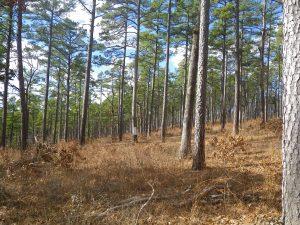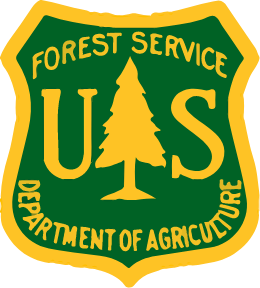by Jennifer Moore Myers, SRS Science Communications • September 27, 2018
Climate change is here. In southern forests, it takes the form of novel disturbances – different frequency and severity of drought, fire, wind storms, insect outbreaks, even ice storms – or a combination of these stressors.
A mature shortleaf pine-bluestem grass woodland on the Ouachita National Forest. One of the trees has a red-cockaded woodpecker nest — and metal flashing to protect the nestlings from predation by black rat snakes. Photo by James Guldin, USFS.
“How will managers respond to the threats posed by changing climate conditions?” asks USDA Forest Service scientist James Guldin. “The answer is, by managing one stand at a time, so that over time, forests will be resistant or resilient in the face of damaging events.”
Guldin recently published an article about forest management and climate change in New Forests. He argues that we need silvicultural practices focused on resilience and restoration.
“Diversity is the key to adaptive forest management,” adds Guldin. “Diversity of genetics within a species, diversity of species composition in the forest, and diversity in the way forests are distributed across the landscape.”
Each type of diversity requires different management steps. The best opportunity to promote genetic diversity is when new stands are established, in both natural and planted stands. In planted stands, managers can monitor the seed sources of planting stock to ensure that they come from genetically diverse seed lots. In naturally-regenerated stands, seedlings that sprout from seed provide different genetics than coppiced sprouts, which are genetically identical to their parents.
Species diversity can be managed as new stands are established and during pre-commercial or commercial thinning treatments. For instance, when marking a thinning, managers get a more diverse stand if both pines and hardwoods are retained, compared to cutting all of the hardwoods to keep only the pines.
A variety of harvest methods can also promote diversity in forest structure within stands and across managed landscapes. Structural diversity can be encouraged by including multi-aged or uneven-aged stands alongside traditional even-aged methods. Managers can use prescribed fire to encourage or control new age cohorts.
This stand of poletimber-size shortleaf pine was planted in the 1980s and is managed with frequent prescribed fire. Native grasses sprung up naturally from existing rootstock. Photo by James Guldin, USFS.
A greater number of age cohorts can give stands additional resistance to some kinds of disturbance – like disease, drought, or wildfire. This approach may be applied to mixed pine and hardwood-dominated stands across the region as well.
Another strategy often discussed in response to changing climatic conditions is assisted migration, the movement of species to locations that might provide suitable climate and habitat conditions in the future.
“From the perspective of the forester, though, assisted migration is really just a special case of artificial regeneration,” notes Guldin. “We’ll have to plant species if they are not present locally. And we’ll have to pay special attention to help the seedlings survive their first year, which is a challenge no matter where seedlings are planted.”
But planting species outside their natural range is fraught with technical and practical challenges.
“I suspect there’s more to assisted migration than just planting a few of the dominant overstory tree species and hoping the rest of the ecosystem will follow,” says Guldin. “Planting seedlings in novel locations, where they may thrive under future conditions, poses a ‘gain vs. risk’ argument. Over the next 30 years, are climate conditions or associated disturbances likely to cause a significant loss? Does that justify the increased costs and uncertainties of planting trees outside of their natural range?”
Sound, adaptive silviculture options will help forest managers prepare for climate-related stressors, reduce their impacts, and sustain healthy, resilient forests for generations to come.
Climate change means greater uncertainty and risk for forests in the future. It brings new challenges for foresters and land managers – a guild that has always anticipated change and planned for the long term, that will adapt and grow alongside the forest ecosystems they manage.
Read the full text of the article.
For more information, email James Guldin at jguldin@fs.fed.us.

A mature shortleaf pine-bluestem grass woodland on the Ouachita National Forest. One of the trees has a red-cockaded woodpecker nest — and metal flashing to protect the nestlings from predation by black rat snakes. Photo by James Guldin, USFS




